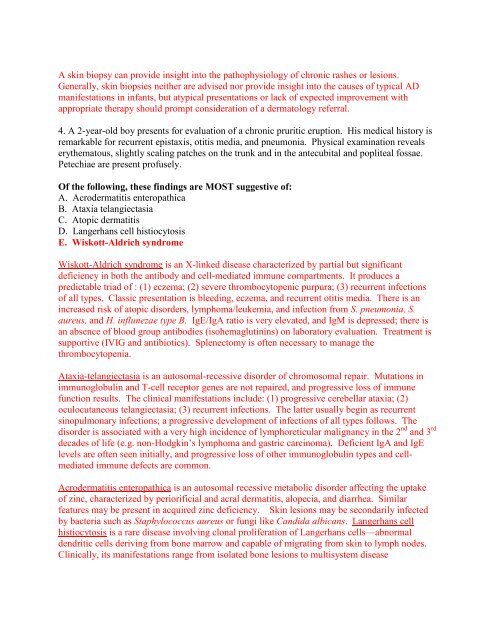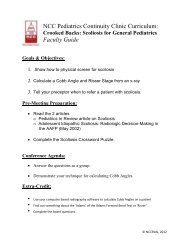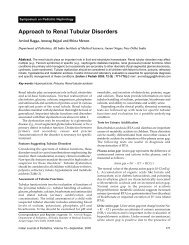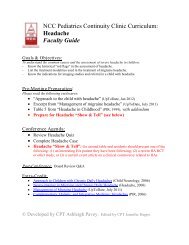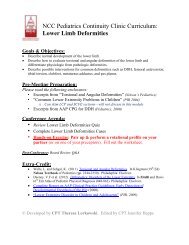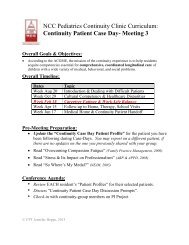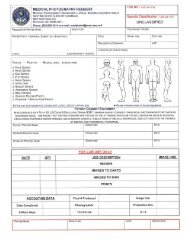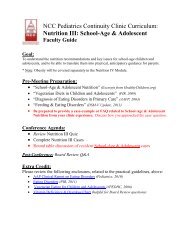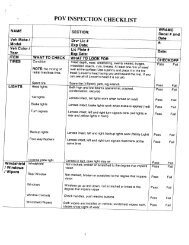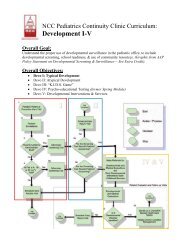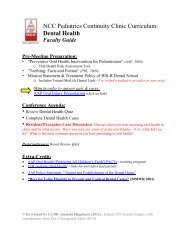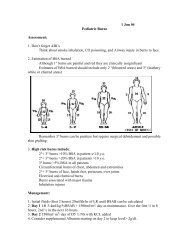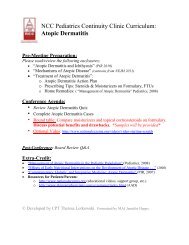NCC Pediatrics Continuity Clinic Curriculum: Atopic Dermatitis ...
NCC Pediatrics Continuity Clinic Curriculum: Atopic Dermatitis ...
NCC Pediatrics Continuity Clinic Curriculum: Atopic Dermatitis ...
Create successful ePaper yourself
Turn your PDF publications into a flip-book with our unique Google optimized e-Paper software.
A skin biopsy can provide insight into the pathophysiology of chronic rashes or lesions.<br />
Generally, skin biopsies neither are advised nor provide insight into the causes of typical AD<br />
manifestations in infants, but atypical presentations or lack of expected improvement with<br />
appropriate therapy should prompt consideration of a dermatology referral.<br />
4. A 2-year-old boy presents for evaluation of a chronic pruritic eruption. His medical history is<br />
remarkable for recurrent epistaxis, otitis media, and pneumonia. Physical examination reveals<br />
erythematous, slightly scaling patches on the trunk and in the antecubital and popliteal fossae.<br />
Petechiae are present profusely.<br />
Of the following, these findings are MOST suggestive of:<br />
A. Acrodermatitis enteropathica<br />
B. Ataxia telangiectasia<br />
C. <strong>Atopic</strong> dermatitis<br />
D. Langerhans cell histiocytosis<br />
E. Wiskott-Aldrich syndrome<br />
Wiskott-Aldrich syndrome is an X-linked disease characterized by partial but significant<br />
deficiency in both the antibody and cell-mediated immune compartments. It produces a<br />
predictable triad of : (1) eczema; (2) severe thrombocytopenic purpura; (3) recurrent infections<br />
of all types. Classic presentation is bleeding, eczema, and recurrent otitis media. There is an<br />
increased risk of atopic disorders, lymphoma/leukemia, and infection from S. pneumonia, S.<br />
aureus, and H. influnezae type B. IgE/IgA ratio is very elevated, and IgM is depressed; there is<br />
an absence of blood group antibodies (isohemaglutinins) on laboratory evaluation. Treatment is<br />
supportive (IVIG and antibiotics). Splenectomy is often necessary to manage the<br />
thrombocytopenia.<br />
Ataxia-telangiectasia is an autosomal-recessive disorder of chromosomal repair. Mutations in<br />
immunoglobulin and T-cell receptor genes are not repaired, and progressive loss of immune<br />
function results. The clinical manifestations include: (1) progressive cerebellar ataxia; (2)<br />
oculocutaneous telangiectasia; (3) recurrent infections. The latter usually begin as recurrent<br />
sinopulmonary infections; a progressive development of infections of all types follows. The<br />
disorder is associated with a very high incidence of lymphoreticular malignancy in the 2 nd and 3 rd<br />
decades of life (e.g. non-Hodgkin’s lymphoma and gastric carcinoma). Deficient IgA and IgE<br />
levels are often seen initially, and progressive loss of other immunoglobulin types and cellmediated<br />
immune defects are common.<br />
Acrodermatitis enteropathica is an autosomal recessive metabolic disorder affecting the uptake<br />
of zinc, characterized by periorificial and acral dermatitis, alopecia, and diarrhea. Similar<br />
features may be present in acquired zinc deficiency. Skin lesions may be secondarily infected<br />
by bacteria such as Staphylococcus aureus or fungi like Candida albicans. Langerhans cell<br />
histiocytosis is a rare disease involving clonal proliferation of Langerhans cells—abnormal<br />
dendritic cells deriving from bone marrow and capable of migrating from skin to lymph nodes.<br />
<strong>Clinic</strong>ally, its manifestations range from isolated bone lesions to multisystem disease


